The innovative Schiaparelli lander is nearing the end of its journey from the ExoMars Trace Gas Orbiter to the Martian surface.
| Update (October 16th): ESA reports that the ExoMars Trace Gas Orbiter is now back online with full telemetry is restored... a little Sunday afternoon space-drama! |
| Update (October 16th): Separation of the Schiaparelli EDM lander from the Mars Trace Gas Orbiter at 16:42 CEST was confirmed by the ESA team at 17:02 CEST. The lander is in good health, and on its way to Mars for a Wednesday landing. Separation signal was received by the Giant Metrewave Telescope in Pune, India. A loss of telemetry was experienced by the Exomars Trace Gas Orbiter post separation. The team is investigating the cause: currently, they're only getting a carrier wave signal from the orbiter minus telemetry. |
| Update (October 16th): ESA is posting live updates for the ExoMars mission from spacecraft separation through landing here. Live video from the European Space Operations Center in Darmstadt, Germany leading up to spacecraft separation starts today (Sunday October 16th) at 14:30 UT/16:30 CEST/10:30 AM EST. |
| Update (October 14th): ESA Operations in Darmstadt, Germany reports that the final flight correction performed today by the ExoMars Trace Gas Orbiter at 10:45 Central European Summer Time (CEST) was successful; there was a small under performance against the targeted 1.4 cm/per second burn that the Flight Dynamics team is reviewing, but Schiaparelli is on track for a 16:42 CEST release on Sunday. |
Get set for a wild ride. On October 16th, the ExoMars Trace Gas Orbiter released a landing craft to demonstrate key technologies for a future ExoMars rover: the Schiaparelli entry, descent, and landing demonstrator module (EDM).
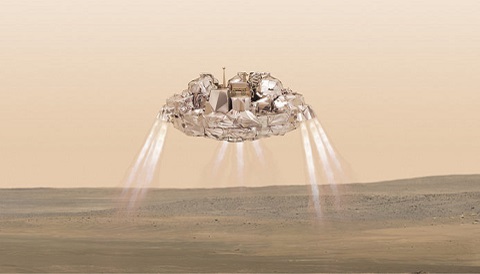
ESA / ATG-Medialab
The joint Roscosmos / European Space Agency mission launched on March 14th atop a Proton rocket from the Baikonur Cosmodrome in Kazakhstan. This was the only mission to make the journey from Earth to Mars during the 2016 opposition season. Thales Alenia Aerospace built both the orbiter and the lander.
The lander is named after 19th-century Italian astronomer and Mars observer Giovanni Schiaparelli, who first described the now-infamous canali ("channels") – later misinterpreted as "canals" — of Mars.
Ground tracking stations began around the clock contact with the ExoMars Trace Gas Orbiter on October 9th. Schiaparelli separated from the orbiter on Sunday, October 16th, beginning a three-day journey to the Red Planet. The 6-minute descent to the surface should occur on Wednesday, October 19th, at 14:48 UT (4:48 p.m. CEST, 10:48 a.m. EDT). Mars is currently about 169 million km (1.128 astronomical units) from Earth, or just over 9 light-minutes away. Schiaparelli is aiming for a touchdown in a 100-by-15-km ellipse in the Meridiani Planum region of Mars.
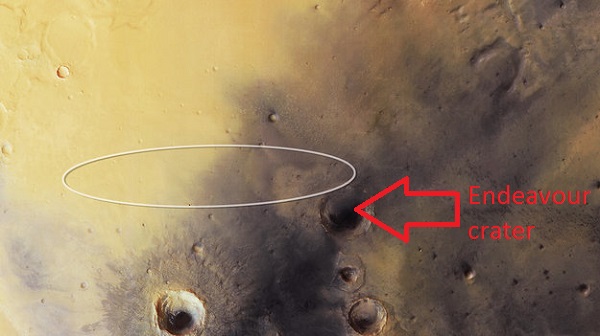
ESA / Mars Express
The ballistic entry of Schiaparelli is closer to that of the Mars rovers Spirit and Opportunity than the guided entry of Curiosity. “The EDM is Europe's first try at landing on Mars, and as landing systems go, it is pretty ambitious,” says Jorge Vago (ESA's ExoMars Project Scientist). “Schiaparelli incorporates a sophisticated Doppler radar to measure distance to the ground and speed over the surface. The information is used to command the pulsed hydrazine engines, which are organized in three clusters of three motors each.”
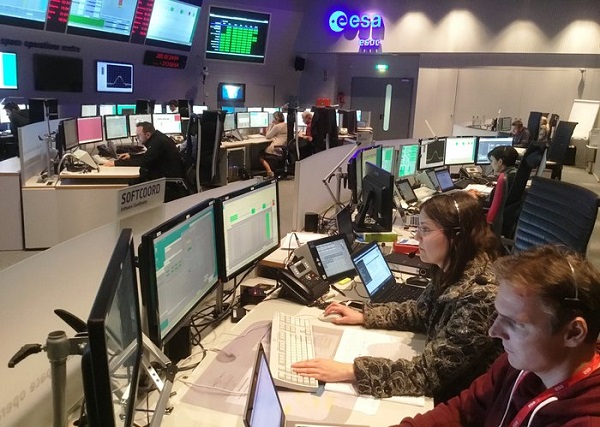
ESA
The Roscosmos and ESA engineers will scale up the platform and use lessons learned from the Schiaparelli EDM landing for the ExoMars rover.
If successful the mission will be the first Mars landing carried out by ESA. The only semi-successful landing on Mars carried out by a space agency other than NASA was the Soviet Union's Mars 3, which fell silent 14.5 seconds after reaching the Martian surface in 1971.
Learn more about the ghoul that haunts Martian landings in our free ebook: Mars Landings, Then & Now. Enter your email to access the free PDF download, plus subscribe to our weekly e-newsletter with the latest astronomy and observing news.
[form id="255440183"]
Early plans for Schiaparelli called for a plutonium-fueled radioisotope thermoelectric generator (RTG) supplied by Russia, but the cost and complexity of such a power source proved too great. The lander doesn't even have solar panels and will instead rely on internal battery power, similar to ESA's Huygens mission which landed on Titan in 2005. At most, Schiaparelli is expected to operate for 2 to 8 sols (Martian days, each 24.7 hours long) on the planet's harsh surface.
Foiling the Ghoul
ESA engineers are bracing themselves for their very own "6 minutes of terror" through entry, descent, and landing. If there's one thing that the fabled "Great Galactic Ghoul of Mars" loves, it's tasty spacecraft sent from Earth. Mars's atmosphere is substantial enough that spacecraft can't ignore it, but it's too tenuous to fully air brake a descending spacecraft. Schiaparelli will use the traditional combination of parachutes, heat shields, and retro-rockets on descent, with one new innovative feature. Instead of the air bags used by Pathfinder, Spirit, and Opportunity, or the sky crane approach used by Curiosity, Schiaparelli has a soft deformable bottom to cushion its impact on landing.
If the Meridiani Planum landing site sounds familiar, it's probably because NASA's Opportunity rover is nearby, exploring Spirit Mount on the rim of Endeavour Crater not far away. "Oppy" is still operational at an amazing 12 years past its warranty of 90 sols and counting, and it just might perform a long-shot "first": spying Schiaparelli on descent from ground level.
“We have asked the Opportunity team, and they will give it a go,” says Vago. “However, it is not a given that we will get a nice image. Simulations show that if we arrive 'short' of the landing spot, we will be below Opportunity's observation horizon. Conversely, if we arrive 'long,' there is a better chance that the EDM and parachute may be imaged.”
High overhead, NASA's Mars Reconnaissance Orbiter will collect Schiaparelli telemetry data 1½ hours after landing, while the ExoMars Trace Gas Orbiter remains out of range on its initial 4 sol-long capture orbit. The Trace Gas Orbiter will perform an engine burn for a "Mars avoidance maneuver" on October 17th, one day after releasing Schiaparelli. The ExoMars Trace Gas Orbiter will also enter orbit around the Red Planet on October 19th.
ESA's Mars Express will also serve as a data relay for Schiaparelli, and the Mars Trace Gas Orbiter will do the same for the future ExoMars rover.
Although Schiaparelli's main mission is demonstrating landing technology, it does carry a small science package for surface studies. The Dust Characterization, Risk Assessment and Environment Analyzer on the Martian Surface (DREAMS) will study the conditions at the expected onset of Martian dust storm season. The DECA (Descent and Entry Camera) will also document the landing and surface phase of the mission.
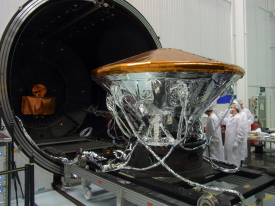
ESA / B. Bethge
“Scientifically, we hope to characterize the entry, descent, and landing conditions during the dust storm season,” says Vago. This sort of on-the-fly measurement will be a first. “Once on the surface, DREAMS will also attempt to measure, also for the first time, the electric fields that develop due to the frictional charging of atmospheric dust.” On Earth, such fields can rapidly accelerate large quantities of dust upward into the atmosphere, causing dust storms. Data from DREAMS could provide insight into the birth and early evolution of Martian dust storms.
Dust Storm Fever
All eyes are on the Red Planet for the start of Martian dust storm season. Northern hemisphere autumn on Mars started back on July 4th, and although dust storms aren't as severe as what you saw in The Martian, they're enough to give spacecraft engineers pause. A planet-wide dust storm doomed Mars 3 back in 1971. Dust storms have also occasionally coated the solar panels of Opportunity and the late Spirit rover, reducing their power. For Schiaparelli, however, the biggest risk is its communication with orbital relays.
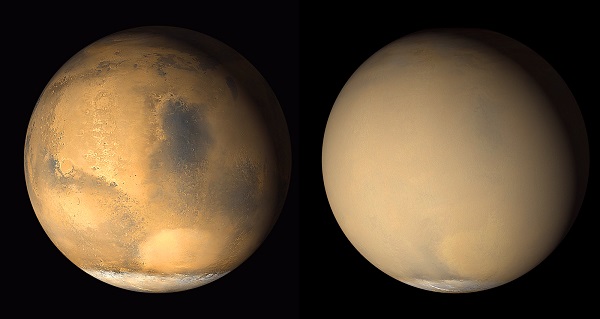
NASA / JPL-Caltech / MSSS
Mars is currently well-placed for evening observers, appearing in the constellation Sagittarius, though its disk is only 8" across and shrinking. Opposition, when the disk is biggest, also marks the optimal launch window, and comes around every 26 months. In 2018, when Mars will appear 24" across in Earthbound telescopes, NASA's Mars InSight lander (which slipped one launch window) will begin its trip. SpaceX also hopes to send an uncrewed Red Dragon spacecraft to Mars in the next window. ESA's ExoMars rover also slipped one window to a July 2020 launch from Baikonur.

NASA/JPL/MRO
Update: Check out this simulation of what sort of view Schiaparelli will have as it descends towards the surface of Mars:
The descent camera will begin taking images from an altitude of 3 kilometers above the surface, about a minute after the heat shield is jettisoned. it will continue to snap an image every 1.5 seconds, right up to landing. This should provide an amazing view next Wednesday.
Although the Schiaparelli's mission is short, ESA's Trace Gas Orbiter will join the armada of human spacecraft in Martian orbit, scanning the atmosphere of Mars for methane, water vapor, and other gases over an expected 7-year life span.
ESA will report lander separation online on October 16th and stream media briefings on October 19th and 20th. Watch this space, as we'll be dropping in images and updates as the mission progresses.
 4
4









Comments
chrfrde
October 14, 2016 at 6:43 pm
"The EDM is Europe's first try at landing on Mars"
Carefully worded so they don't have to count the failed British Beagle 2 it seems 🙂
Or maybe its a #brexit thing.
You must be logged in to post a comment.
David DickinsonPost Author
October 14, 2016 at 11:37 pm
The ill-fated British Beagle 2 Mars Lander did hitch a ride on ESA's Mars Express, yes.
Thanks,
Dave Dickinson
You must be logged in to post a comment.
robin_astro
October 14, 2016 at 7:08 pm
“The EDM is Europe's first try at landing on Mars..."
err..... Beagle 2 ?
You must be logged in to post a comment.
robin_astro
October 14, 2016 at 7:44 pm
Ha! beaten to it 🙂
You must be logged in to post a comment.
You must be logged in to post a comment.